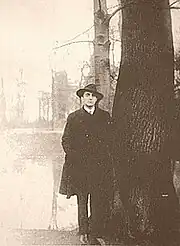Otto Rahn
Otto Wilhelm Rahn (18 February 1904 – 13 March 1939) was a German medievalist, Ariosophist, and SS officer who researched Holy Grail myths.
Otto Rahn | |
|---|---|
 | |
| Born | 18 February 1904 |
| Died | 13 March 1939 (aged 35) |
| Alma mater | University of Giessen (BA) |
| Known for | Crusade Against the Grail Lucifer's Court in Europe |
| Scientific career | |
| Thesis | To the Research of Master Kyot of Wolfram von Eschenbach |
| Military career | |
| Branch | |
| Years | 1936-1939 |
| Rank | Obersturmführer |
Early life and work
Rahn was born February 18, 1904, to Karl and Clara (nee Hamburger) in Michelstadt in the Hesse region of the German Empire. From an early age, Rahn's mother introduced him to the stories and legends of Parzival, the Holy Grail, Lohengrin and the Nibelungenlied. While attending the University of Giessen, he was inspired by his professor, Baron von Gall, to study the Albigensian (Catharism) movement and the massacre that occurred at Montségur. In 1924, he gained a degree in philology, specializing in literary history of the language and romances of France.
In 1931, he travelled to the Pyrenees region of southern France where he conducted most of his research. Aided by the French mystic and historian Antonin Gadal, Rahn argued that there was a direct link between Wolfram von Eschenbach's Parzival and the Cathar Grail mystery. He believed that the Cathars held the answer to this sacred mystery and that the keys to their secrets lay somewhere beneath the mountain peak where the fortress of Montségur remains, the last Cathar fortress to fall during the Albigensian Crusade.
SS service and death
In 1934, Rahn published his first book, Kreuzzug gegen den Gral ("Crusade Against the Grail"), which attempted to link the medieval romance of Parzival with the real-life repression of the Cathars by the Pope. The book sold only a few thousand copies, but it came to the attention of Karl Maria Wiligut, head of the department for pre- and early history of the SS Race and Settlement Main Office.Wiligut was impressed by the book and passed it to Heinrich Himmler, the head of the SS, who was fascinated by the occult and had already initiated research in the south of France. Rahn joined his staff as a junior non-commissioned officer and became a full member of the SS in 1936, achieving the rank of Obersturmführer.
Journeys for his second book led Rahn to places in Nazi Germany, France, Kingdom of Italy, and the Kingdom of Iceland. Openly homosexual, frequenting anti-Nazi circles, and having fallen out of favour with the Nazi leadership, Rahn was assigned guard duty at the Dachau concentration camp in 1937 as punishment for a drunken homosexual scrape.[2] He resigned from the SS in 1939.[2]
The SS would not allow anyone to resign without consequences.[2] Soon, Rahn learned the Gestapo was after him, and he was even offered the option of committing suicide.[2] He vanished, and on 13 March 1939, nearly on the anniversary of the fall of Montségur, Rahn was found frozen to death on a mountainside near Söll (Kufstein, Tyrol), in Austria. His death was officially ruled a suicide.[2]
Rahn in popular culture
Rahn has been the object of many rumours and strange stories, including that his death had been faked, although all such speculation is unsubstantiated.[2]
- In the Italian comic book Martin Mystère, Rahn fakes his death and joins the United States Secret Service "Elsewhere".[3]
- The Pale Criminal (1990), part II of Philip Kerr's Berlin Noir trilogy, has Rahn as a secondary character.
- Richard Stanley made a documentary about Rahn and his fixation on the Holy Grail titled The Secret Glory in 2001.
- The 2013 Snog album Babes in Consumerland features the song "Otto Rahn".[4]
- The band Civil War, in the album "Killer Angels", features the song "Lucifer's Court" about Rahn.
- Sorcerer's Feud (2014) by Katharine Kerr is another novel that has Rahn as a character.
Works
- Kreuzzug gegen den Gral. Die Geschichte der Albigenser (Broschiert) (in German), 1934, ISBN 3-934291-27-9; ISBN 978-3-934291-27-0.
- Croisade contre le Graal: Grandeur et Chute des Albigeois (Broché) (French translation), 1934, ISBN 2-86714-184-2; ISBN 978-2-86714-184-3.
- Crusade Against the Grail: The Struggle between the Cathars, the Templars, and the Church of Rome (First English Translation by Christopher Jones), 1934–2006, ISBN 1-59477-135-9; ISBN 978-1-59477-135-4.
- Luzifers Hofgesind, eine Reise zu den guten Geistern Europas (in German), 1937, ISBN 3-934291-19-8; ISBN 978-3-934291-19-5.
- Lucifer's Court: A Heretic's Journey in Search of the Light Bringers (English translation), 1937–2008, ISBN 1594771979; ISBN 978-1594771972.
References
- Otto Rahn's Christian headstone (family grave)
- John Preston, The original Indiana Jones: Otto Rahn and the temple of doom, The Telegraph, 22 May 2008.
- "Martin Mystère – Il segreto di San Nicola". En.sergiobonellieditore.it. Archived from the original on 2011-07-20. Retrieved 2011-04-19.
- "Snog - Babes in Consumerland at Discogs". Discogs. Retrieved 13 September 2015.
Sources
- Nicholas Goodrick-Clarke. 1985. The Occult Roots of Nazism: Secret Aryan Cults and Their Influence on Nazi Ideology: The Ariosophists of Austria and Germany, 1890-1935; p. 188-189
- Otto Rahn and the Quest for the Holy Grail
- Sabeheddin, M (July–August 1997). "Otto Rahn & the Quest for the Holy Grail (New Dawn No. 43)". New Dawn Magazine. New Dawn International News Service. Archived from the original on 2009-10-27.
- Biography at Jones' Celtic Encyclopedia
External links
Wellspring: The Grail,The Reich, and the Man in the Black Hat A novel, Saunders, Tracy, Priscillian Press (2023)
- Website dedicated to Otto Rahn, otto-rahn.com
- Raiders of the Lost Grail, an article by Richard Stanley
- The Secret Glory (2001) at IMDb
- Crusade Against the Grail by Otto Rahn the full text of the book at the Internet Archive